Happy Holidays
Whether you’re celebrating Hanukkah, Christmas, Kwanzaa, or one of the myriad of holidays and festivals this season brings, I wish you many joyful times and good cheer with family and friends!
Whether you’re celebrating Hanukkah, Christmas, Kwanzaa, or one of the myriad of holidays and festivals this season brings, I wish you many joyful times and good cheer with family and friends!
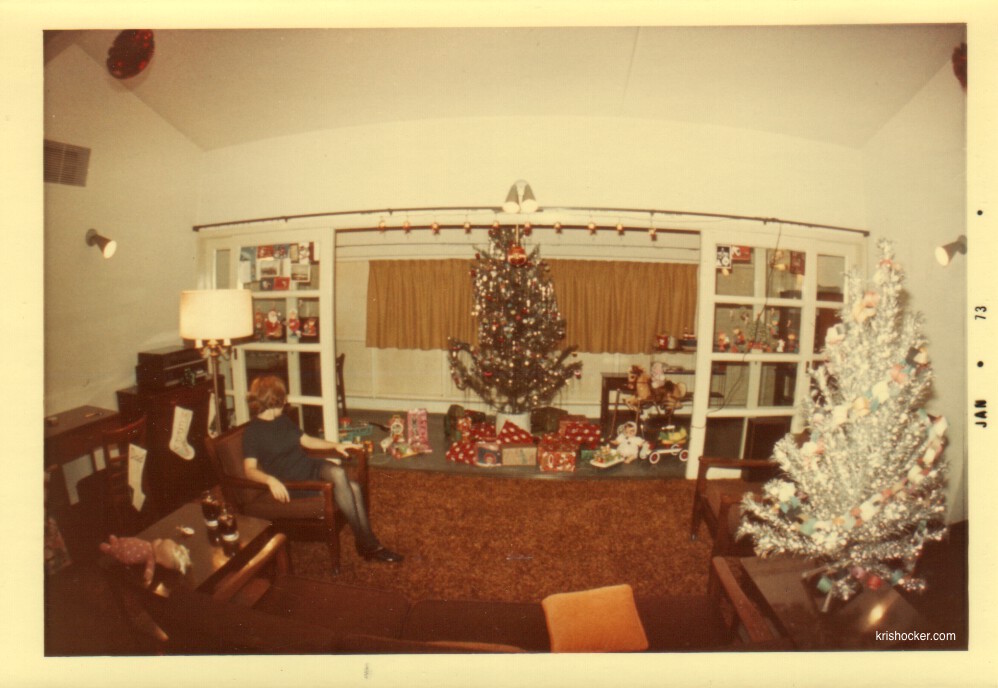
Christmas Eve 1972, the before photo
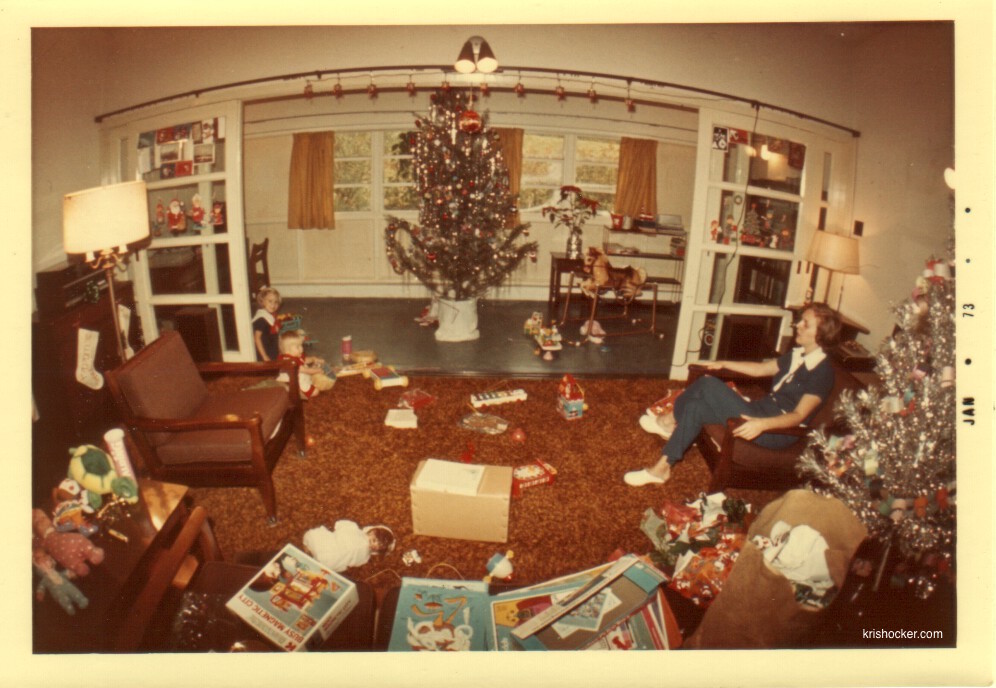
Christmas day 1972, the after photo
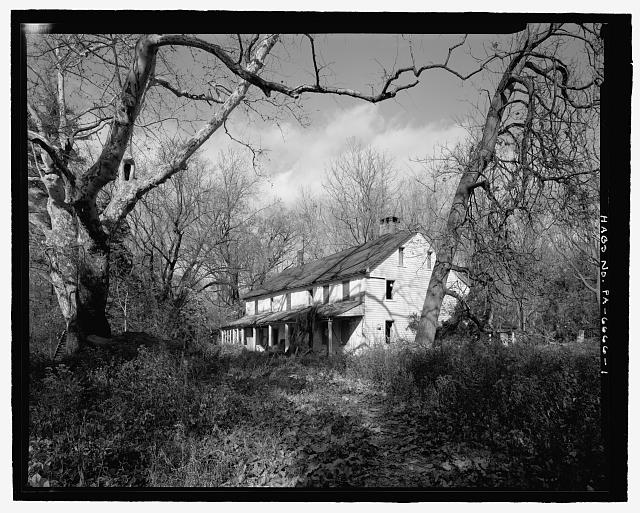
The Scheetz family farm in Fort Washington
On 12 May 1786, Elizabeth Hocker, daughter of Johann Georg and Anna Margaretha Hacker, married General Henry Scheetz, son of Henry and Catharine Scheetz. Henry Scheetz served in the Revolutionary War (hence the title of General). He was in charge of a county brigade during the Fries Rebellion in 1798, but when the brigade arrived on site, the rebellion had already subsided. He later served in many prominent positions in local business and government.
His father inherited this property from his father—another Henry Scheetz. The family built a paper mill on Sandy Run in 1769 and later added a grist-mill. According to the Library of Congress, the “Scheetz family were prominent farmers, paper millers, public officials, and military veterans. The property achieved local prominence as the site of Scheetz paper mill, built in 1769 and destroyed in 1929.”
This image and others—including some of the house, barn, poultry shed, and garage—can be found on the Library of Congress’ website at “Scheetz Farm, 7161 Camp Hill Road, Fort Washington, Montgomery County, PA” and associated pages. Take a look and see what you can find for your family.
Godfrey Wißler wrote his last will and testament on 23 April 1825. It was proven on 21 October 1829.1 He died before 21 October 1829.2 Based on this will, his wife Eva Catharine (Weiß) Wißler had died previously. At the time of his death, he had three living daughters, as well as the four surviving grandchildren of his deceased daughter Elizabeth (Wißler) Reiter.
Will of Godfrey Wisler
In the Name of God Amen I Godfrey Wisler of Upper Hanover Hanover township Montgomery County and State of Pennsylvania Yeoman being in perfect health of body and of sound mind memory and understanding blessed by God for the same but considering the uncertainty of this transitory life Do make and publish this my last will and testament in manner and form following to wit Principally and first of all I commend my Immortal Soul into the hands of God who gave it and my body to the earth to be buried in a decent and Christian like manner at the discretion of my Executors hereinafter named and as to such wordless estate wherewith it hath pleased God to bless me in this life I give and dispose of the same in the following manner to wit First it is my will and I do order that all my just debts and funeral expenses be duly paid and satisfied as soon as conveniently can be after my decease Item I give unto my youngest daughter and do order my executors to get the same and pay for the same out of my estate unto my youngest daughter Susanna one good and sufficient bed and bedstead and all belonging to the same one cow Spinning weel and drawre and one kittle two iron potts a washtub two buckets a half dozen Knifes and forks one dozen table spoons one dozen tea spoons one dozen plates one dozen cups and sarcers a half doz chairs one table all new and the greater pewter dish Item it is my will that all my personal estate shall be sold by Public Vendue by my Executors hereafter named and the money arriving thereof after due expenses be paid off equally divided share and share alike amongst all my children and grandchildren or to their respective Heirs to wit one fourth to my Grand children born by my daughter Elizabeth deceased (the wife of George Reiter) one fourth to my daughter Catharine (the wife of Jacob Stoyer) one fourth to my daughter Sarah (the wife of Henry Snyder) and one fourth to my daughter Susanna Item it is my will and I do order that my real estate shall be sold by my Executors on Public Sale for the best price may be gotten for the same and the money arriving there from after all expenses be duly paid then it is my will and I do order that first fifty dollars shall be paid unto Jacob Stoyer the husband of my daughter Catharine or to their heirs which said sum and the land I have given already unto them shall be in full of their share and dividents whatever Item it is my will that all the remaining money over the real estate shall be divided equally into three parts that is to say one third unto my four Grand Children by twenty dollars more than her share unto my Grand daughter Eve Reiter and one third unto my daughter Sarah and one third unto my daughter Susanna unto them or to their respective heirs or assigns And Lastly I nominate Constitute and appoint my trusty frands George Hillegas Sr. and George Maurer to be the sole Executors of this my last will and testament and give them full power and authority or the Surveyeor of them to Sign Seal and deliver a good and Suficient title deed to purchaser or purchasers of the same hereby revoking all other will legacies and bequests by me heretofore made and declaring this and no other to be my last will and testament In Witness whereof I have hereunto set my had and Seal the twenty third day of April in the year of our Lord one thousand eight Hundred and twenty five
Godfrey Wisler {seal}
Signed Sealed and declared by the said testator as his last will and testament in the presents of us
John Welker George Hillegas
Montgomery County Ss Personally appeared the witnesses to the foregoing will who being duly sworn according to Law did on their solemn Oath respectively say that they Saw and heard Godfrey Wisler the testator therein named sign and seal publish and declare the same will for and as his last will and testament and at the doing of it he was of sound mind memory and understanding to the best of their knowledge and belief Sworn October 21st 1829
Geo M. Potts DR
Be it remembered that on the 21st day of October AD 1829 the foregoing will was proved in due form of Law and Letters of administration with the will annexed Granted unto Jacob Stoyer he having first be duly qualified to execute the same and to render and account thereof according to Law and to comply with the provisions of an Act of Assembly relative to Collateral Inheritances Given under my hand and Seal of office ~
I’ve been able to identify five daughters of Godfrey Wißler and Eva Catharine Weiß:
Henry Snyder purchased 62 acres from Godfrey’s estate in 1830 and got a mortgage from George Hillegas Sr. This became the Snyder and later the Greulich farm across from the New Goshenhoppen Church in Upper Hanover Township.
Godfrey and Eva Catharine are my 5x great-grandparents.
How many interfamily marriages do you have in your genealogy database? I currently have 79 couples. Just an interesting fun fact, right?
Not so fast. Interfamily marriage is defined as marriage between people with common ancestors, aka cousin marriage, and this is how pedigree collapse occurs.
What is pedigree collapse, you ask. If you count your ancestors, you should theoretically double the number for each generation you go back. Two parents. Four grandparents. Eight great-grandparents. And so on.
However, if you actually look at your family tree, the deeper you go, the less likely this calculation is to be valid.
Why?
Before too many generations, your number of many-times great-grandparents would exceed the number of all people living at that time.
So, what actually happened? Interfamily marriages.
One expert estimates that nearly 80 percent of all marriages in the past occurred between first or second cousins.1 This means that the spouses’ ancestors appear in their descendants’ family trees multiple times. So, there are actually fewer ancestors than expected based on the simple calculation referenced above. Instead of an ever-expanding pedigree, you get points where the pedigree has collapsed.
I’ve seen this in action on both sides of my family tree. On my father’s side, I’m descended from Andrew Walker Sr. and his wife Catharine Margaret Fetzer three times through their children: John and his wife Mary Lucas, Catherine and her husband George Walker, and Mary Ann and her husband John Mayes. I am allegedly descended from Johann Michael Haudesheldt and his wife Maria Dorothea Seitel through two of their sons: Lawrence and Michael.
On my mother’s side of the family, I’m descended from Johann Michael Klein Sr. and his second wife Maria Catharina Kuntz twice through their daughter Maria Magdalena and her husband Conrad Brey, and their son Johann Jacob and his wife Eva Elisabetha Heilig. I’m descended from David Yeakel and his wife Susanna Heydrick through sons Johannes Henrich and his wife Susanna Heydrick,2 and Jeremias and his wife who was a Wolf. In fact, Jeremias serves as a point of collapse, too, because I descend through two of his daughters: Charlotte who married Andrew Schultz, and Catharine who married Conrad Wolf.
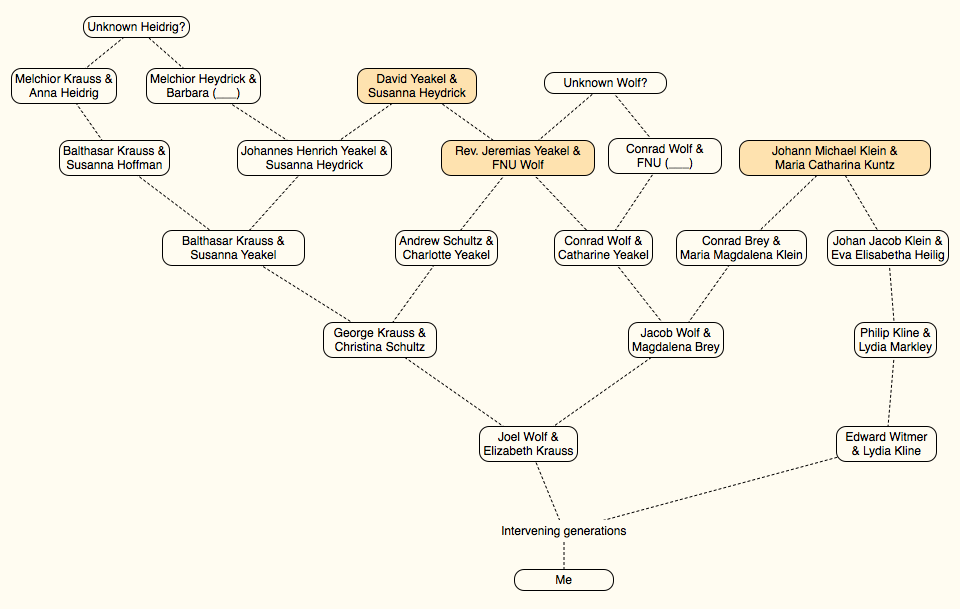
Maternal line pedigree points of collapse
Yeakel and Heydrick (Heidrig) appear elsewhere in my pedigree with Rosina Yeakel, daughter of Balthasar and Regina (John) Yeakel, wife of Rev. Christopher Schultz, and Anna Heidrig who was the wife of Melchior Krauss, whose grandson Balthasar Krauss married Susanna Yeakel, daughter of Johannes Henrich and his wife Susanna Heydrick. It’s likely that if I were to trace these families back through Germany, I’d find additional points of collapse.
These are just the families I’ve found in my direct ancestry. Collateral lines have additional cousin marriages. And then there are those relations who are yet unproven. For instance, I have “Hartzel” and “Hertzel” ancestors who were said to be brothers. How many more points of collapse will I find as I go further back?
That interesting fun fact is actually useful in your research. Related families often moved and settled together. Cousin marriages one or two generations on were not uncommon. From our perspective, working backward through our family lines, these marriages may not appear to be cousin marriages. Our ancestors may or may not have known they were cousins, but we don’t. It’s only after we get back another generation or two that we finally make the connection and see the relationships.
It may not even be your line that reveals the relationship. So, if you’re stuck, researching those around your brickwall—friends, siblings, neighbors, associates—may be more help than you think. Check out the in-laws, too. Who knows, they may just be family.
In my last post regarding George3 Hocker Jr.’s (Johann George2, Christopher1) date of death, I had to evaluate conflicting information to determine George’s approximate date of death. Based on that information I could only conclude that George died sometime prior to 16 October 1821, the alleged death date of his father.1
Now, based on his administration account, I know that George3 Hocker Jr. died prior to 3 October 1800. On that date, his widow Mary Hocker filed an admin. bond with Henry Scheetz, paper maker of Montgomery County,2 Jacob Snyder, grocer of Philadelphia, and Jacob Lentz, storekeeper of Germantown.3 She and Henry were named administrators of George’s estate; Jacob Snyder and Jacob Lentz were the sureties. An inventory of his estate was taken on 24 October 1800. It included accoutrements appropriate for an innkeeper, including: “5 pine tables & 2 benches,” “2 doz. Windsor chairs,” “3 tin coffee Potts & 1 Kettle,” “6 pewter Quart & 6 pewter pint mugs,” “2 China Bowles & 3 servers,” “1 Barr top,” “1 [hogshead] Cherry Rum,” and approximately 10 feather beds and bedsteads.4 On 14 June 1806, Mary Hocker and Henry Scheetz sold a lot in the Northern Liberties for $500.5
Putting this information together with the prior information, I can say that George3 Hocker Jr. died sometime between 1 June 17976 and 3 October 1800, at most a couple months before 3 October and most likely in September.
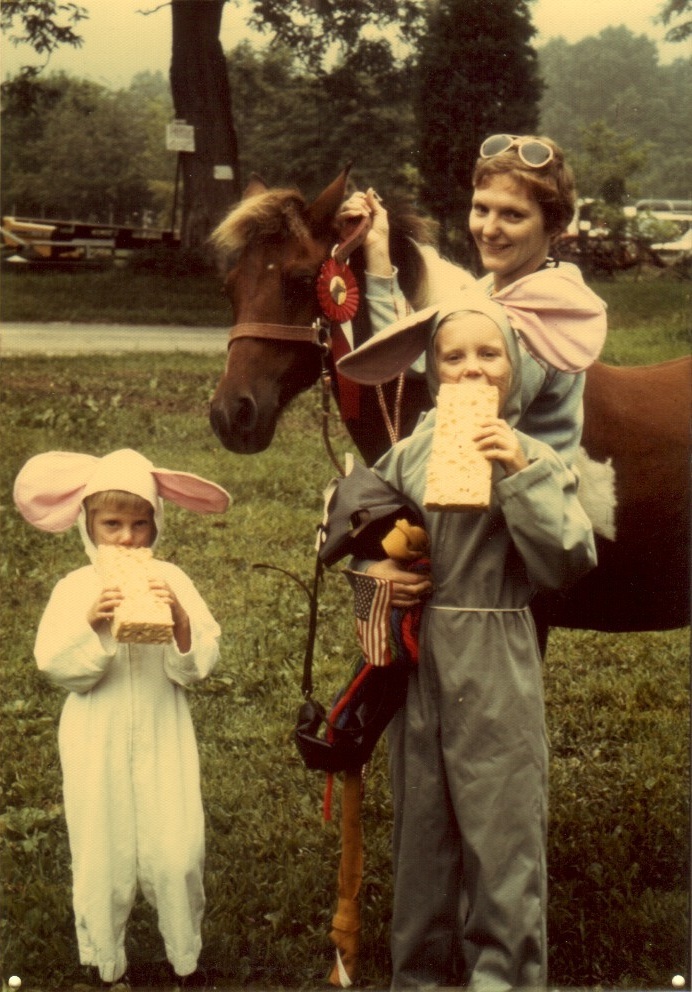
When my sister and I were little, we’d spend weeks with my grandparents during the summer. This meant also spending time over at the barn that my Aunt managed, riding our pony “Christopher Robin.” These visits usually coincided with one of the annual horse shows my Aunt held. So, she would have fun coming up with costumes for Christopher and the two of us for the always hilarious costume class.
In this photo we were two mice and Christopher was an elephant—that’s his “trunk” that I’m holding with the flag. My aunt had fun by putting grain in the bottom of it, so Christopher kept tossing his head, trying to get the grain as I tried to lead him around the ring. I don’t even remember how many times I got hit by that trunk, but it was more than once, I’m sure.
Still, as you can see in the photo, we took second place that day. And were only too happy to mug it up for the camera afterward. Fun childhood memory.
Way back in October of 2015, I wrote a post about the search for Henry Schneider of Upper Hanover Township’s parents. Based on census research, I hypothesized that Henry was possibly the son of Jacob and Catharine (___) Snyder of Upper Hanover Township and may have had a brother named Jacob and sisters named Catharine and Elizabeth.
There were entries with a Jacob Snyder as the head of household in the 1800 through 1820 United States Federal Census enumerations. In 1830, Catharine Snyder was the head of the household, indicating that Jacob likely died sometime in between 1820 and 1830.
Searching the Orphan’s Court records for this period yielded the petition of Catharine Snyder and Henry Snyder, administrators of Jacob Snyder of Upper Hanover Township.1 According to the petition, Jacob died intestate and left children, as follows: Henry, Jacob, Elizabeth, Catharine, Samuel, Daniel, Michael, John, Sarah, and Jonas. The youngest, Sarah and Jonas, were yet minors. The record states that Jacob’s personal estate was not enough to pay his debts and the family wanted to sell his 85 acres of land. Peter Gery and Jacob Griessemer were the sureties for the bond.
The widow Catharine went to Court to petition for a guardian for her son Jonas on 16 November 1829.2 The Court appointed Michael Gery of Hereford Township, Berks County. Her daughter Sarah Snyder, who was over the age of 14, petitioned the Court to allow her to choose her guardian. She chose Conrad Brey and the Court approved him.
On 21 November 1829, Henry sold Jacob’s land to Michael Gery of Berks County for $30 per acre, totaling $2,550. Catharine and Henry presented their administration of the estate to the Court on 13 April 1831.3
Thus, in these records we not only have Jacob and Catharine Snyder, Henry’s possible parents, as members of one family, but also Jacob, Elizabeth, and Catharine, Henry’s possible siblings as named in the New Goshenhoppen Church register.4 In this one family, we find all the hypothesized connections found previously in other records.
There are also clues to other possible relatives in the bond sureties and guardians appointed for her two youngest children: Peter Gery, Jacob Griessemer, Conrad Brey and Michael Gery. When you consider that there was an Elizabeth Snyder the correct age to be Henry’s sister living in the Joseph Gery household in Upper Hanover Township in 1850,5 it is not unreasonable to conclude that there may have been a connection between this Schneider family and the Gery family of Hereford Township, Berks County. Especially, when Joseph Gery and his wife Anna sponsored a daughter of Daniel Schneider at New Goshenhoppen Church in 1834.6 It’s entirely possible that this Daniel was the son of Jacob and Catharine Snyder.
Furthermore, Gertraut Griesemer of Hereford Township married Jacob Gery and had children, including sons named Jacob, Peter and Michael.7 So, there is a connection between the Gery and Griesemer families, as well.
So, does this prove that Jacob and Catherine were Henry’s parents? I think it shows that it is a workable hypothesis, but I’d want more information before calling it “proof.” What I need to know now: Who exactly were Peter Gery, Michael Gery, Jacob Griesemer, and Conrad Brey? How were they related—if they were—to Jacob and/or Catharine? To have these men appear in these records, certainly raises a flag, indicating more research on them and their families is required. Any additional connections I find or don’t find between the families will help to prove or disprove the possibility of a familial relationship.
The Lancaster County (Pennsylvania) Archives has a great list of indices to their records. Have you checked it out lately?
Do you have relatives that owned land in Carroll County, Ohio? Deed records (1833-1876) are available for online viewing at FamilySearch.